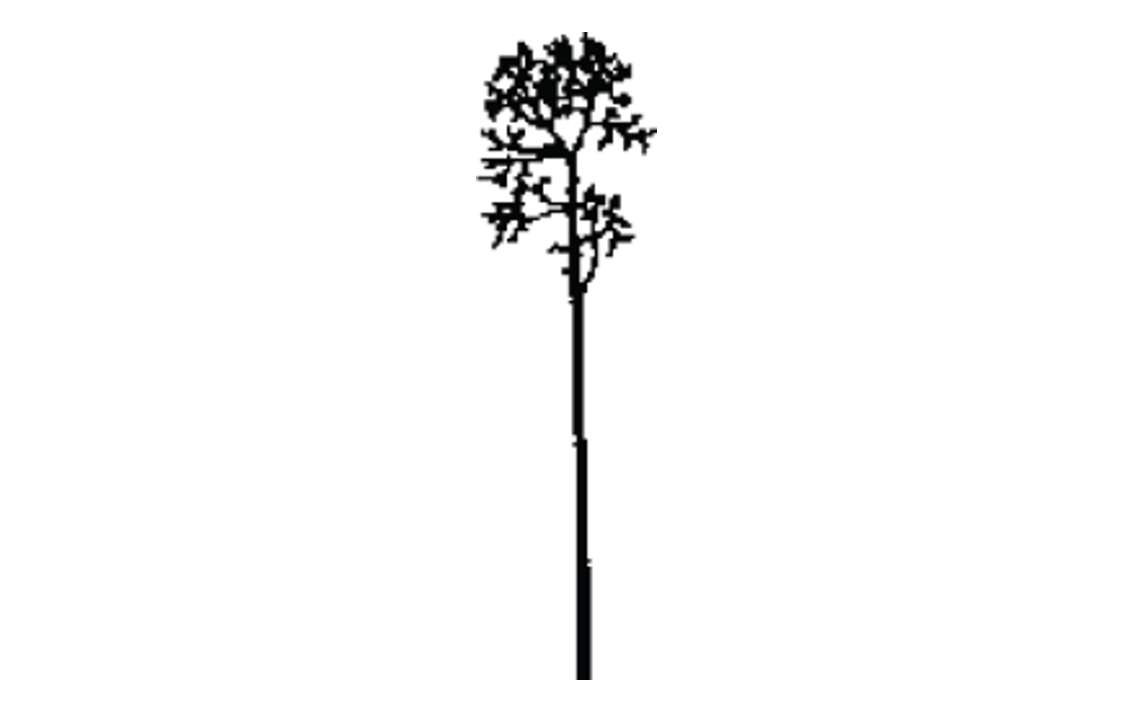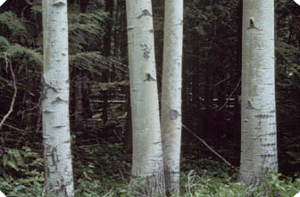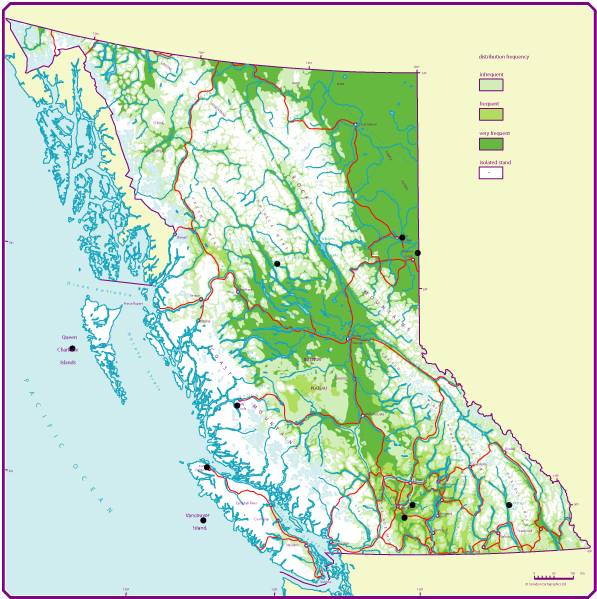Trembling aspen
On this page
- Geographic range and ecological amplitudes
- Tolerances and damaging agents
- Silvical characteristics
- Genetics and notes
Geographic range and ecological amplitudes
Description
Trembling aspen is a medium-sized (<40m tall), deciduous broad-leaved tree, at maturity with a short, rounded crown, smooth, cylindrical stem, and greenish gray, furrowed bark. Many kinds of wildlife use the foliage, twigs, and buds for food. The wood is light and soft and used for lumber, oriented strand-board, and pulp.
Geographic range
Geographic element:
North American transcontinental-incomplete
Distribution in Western North America:
north in the Pacific region; north, central, and (south) in the Cordilleran region
Ecological amplitudes
Climatic amplitude:
(alpine tundra -) subarctic - subalpine boreal - montane boreal - cool temperate - (cool mesothermal)
Orographic amplitude:
submontane - montane - (subalpine)
Occurrence in biogeoclimatic zones:
(SWB), (ESSF), MS, BWBS, SBS, (SBPS), (BG), (PP), IDF, ICH, (CDF), (CWH)
Edaphic amplitude

Range of soil moisture regimes:
(very dry) - moderately dry - slightly dry - fresh - moist – (very moist)
Range of soil nutrient regimes:
(very poor) - poor - medium - rich - very rich
The nutrient amplitude of trembling aspen is similar to that of white spruce; however, trembling aspen returns to the soil greater quantities of nutrients (especially nitrogen, calcium, and magnesium) through its litterfall than white spruce does, thus improving humus form quality of the sites in which it grows. As a result, Moder humus forms develop in aspen-dominated ecosystems compared to the Mors that develop in white spruce-dominated ecosystems. Consequently, a small proportion of aspen trees in white spruce stands is recommendable for improving decomposition and mineralization of surface organic materials, and hence, increasing the level of plant-available soil nutrients.
Tolerances and damaging agents
Root system characteristics
In upland, freely drained soil, trembling aspen develops a heart root system. The shallow and extensive laterals have cord-like branch roots that undulate and meander for great distances without tapering. These roots are the main producer of suckers, particularly when they are close to the soil surface. Sinker roots occur as frequently as every meter on the lateral roots, and may descend to a depth of 3m. Roots are associated with ecto- and endo-mycorrhizae.
| Tolerance to | Tolerance class | Comments |
|---|---|---|
| low light | L | possibly higher in saplings that have developed from root suckers, perhaps due to juvenility |
| frost | H | a major species in boreal climates |
| heat | M | frequent on insolated sites |
| water deficit | L | frequent on dry sites |
| water surplus | H | tolerates flooding and a strongly fluctuating water table well |
| nutrient (mainly N) deficiency | M | infrequent in acid, very poor soils |
| Damaging agent | Resistance class | Comments |
|---|---|---|
| snow | M | high snowfall will break branches instead of boles |
| wind | M | high winds will break the boles rather than uproot trees |
| Risk class | ||
|---|---|---|
| fire | M | it regenerates even at fire intervals as short as 3 years |
| insect | L | not a serious concern; defoliators (for example, Malacasoma spp., Choristoneura spp.); wood-boring insects (for example, poplar borer, Agrilus spp.); sucking insects (aphids and leafhopers) |
| fungi | M | butt and root rots (for example, aspen root rot); cankers (for example, Ceratocystis spp., Cytospora spp.); leaf rust fungi (Melampsora spp.); not a serious concern – aspen and poplar leaf and twig blight |
| other agents | L | not a serious concern; browsing, barking, and bark-eating by mammals |
Associated tree species and successional role
In British Columbia, trembling aspen grows in prevailingly even-aged, pure stands, and, in later successional stages with many shade-tolerant conifers. Trembling aspen may be a pioneer (primary succession) species but it is present most frequently in early and intermediate stages of secondary succession. On some sites, the process of replacing aspen may be as long as 1,000 years. The presence of uneven-aged aspen stands in western North America suggests that under certain conditions, aspen may be self-perpetuating without major disturbance, i.e., it may actually be a climax species. In the absence of replacement by shade-tolerant tree species, pure aspen stands gradually deteriorate to an open-canopy, shrub-dominated woodland, with a few scattered aspen suckers.
| Associated tree species |
Occurance class | Major area of occurance |
|---|---|---|
| white spruce (and hybrids) | H | mainly in BWBS and SBS |
| lodgepole pine | M | mainly in BWBS and SBS |
| common douglas | M | in interior populations |
| subalpine fir | L | mainly in BWBS and SBS |
| paper birch | L | throughout the range of aspen except in SWB and ESSF |
| black spruce | L | mainly in BWBS |
| balsam poplar and Black cottonwood | L | throughout the native range of aspen |
Genetics and notes
Genetics
In aspen, the clone is a biological entity — a multi-stemmed individual that may be thousands of years old. Trembling aspen is known to hybridize naturally with several Populus species.
Notes
Trembling aspen can produce in a relatively short time (about 50 years) high yields of wood. Considering its productivity, vegetative reproduction, and low risk of being affected by damaging agents, it is a suitable species for intensive management on some montane boreal sites. This option may be more feasible than expensive conversion of pure aspen stands to conifers. The species displays wide genetic diversity including polyploidy, which may be used in future breeding programs to produce individuals with superior form, wood properties, and growth rate. More detailed silvics information is given by:
DeByle, N.V. and R.P. Winokur. (editors) 1985. Aspen: ecology and management in the western United States. Gen. Techn. Report RM-119, USDA For. Serv., Fort Collins, Colorado. 283 pp.
Navratil, S. and P.B. Chapman. (editors) 1991. Aspen management for the 21st century. For. Can., Northern Forestry Centre, Edmonton, Alberta. 174 pp.
Perala,. D.A. 1990. Populus tremuloides. Pp. 555-569 in R.M. Burns and B.H. Honkala (technical coordinators) Silvics of North America, Vol 2. Agri. Handbook 654, USDA For. Serv., Washington, D.C.
Peterson, E.B. and N.M. Peterson. 1992. Ecology, management, and use of aspen and balsam poplar in the prairie provinces. Special Report 1, For. Can., Northern Forestry Centre, Edmonton, Alberta. 252 pp.
Peterson, E.B. and N.M. Peterson. 1995. Aspen''''s managers handbook for British Columbia. FRDA Reort 230, B.C. Min. For., Victoria, B.C. 110 pp.

This is the general shape and outline of the trembling aspen.

Trembling aspen is a characteristic species of the montane boreal and cool temperate forests of BC. The picture shows excellent stem form in a mature trembling aspen cohort.

